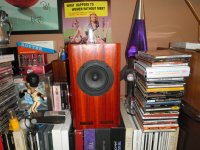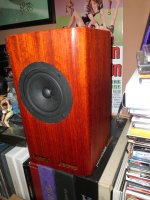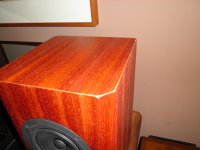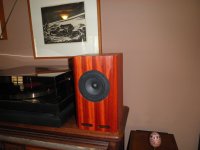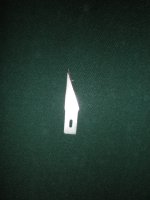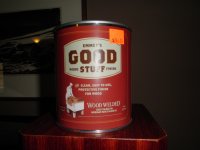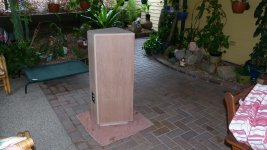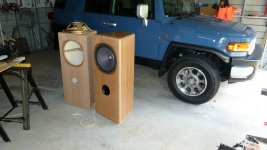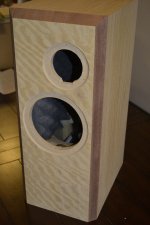Hi Folks,
I recently veneered my third set of speakers and am frankly disappointed in the results. I'm glad that cheaper Band-It veneer from the hardware store was used on my first two sets, but was expecting much better this time with a more expensive and nicer looking Paudak veneer.
While I've learned to build amps and speakers fairly quickly over the years, it seems finishing/veneering is a much flatter and slower learning curve.
I decided not to use the Band-It veneer trimmer this time around (horrific results on a pair of sub woofs), but instead used an exacto blade/knife. Contact cement, a scraper and iron completed this project's construction ensemble.
I'm still having problems with cross-grain cuts despite changing the blade frequently, though it looks worse in these photos than "in person." I need to improve my technique as I have 3 other sheets of nice African Bubinga, SouthAmerican Rosewood and some burl whose name I forget...yes, I went nuts at the veneer store!
I'm scoring several passes before the final cut and the only thing I can think of is that my #2 exacto blades are too pointy for cross grain cuts....should I try a rounded edge blade? ....it did feel like my blade was going over speed bumps on the paduak.
Pictured below is the easiest and best looking finish I've ever used: a jelly form of polyurethane/tong oil/mineral spirit blend which I applied once with a rag.
Despite the untidy edges, I'm glad I used nicer veneer this time as I've concluded that a mediocre/poor job with nicer veneer still looks better that that with cheaper veneer.
Any tips for better cross grain trims or anything else? I appreciate all of you whose posts I read before this most recent attempt and I hope my fourth, fifth and sixth attempts improve. Thanks!
Regards,
Mario
I recently veneered my third set of speakers and am frankly disappointed in the results. I'm glad that cheaper Band-It veneer from the hardware store was used on my first two sets, but was expecting much better this time with a more expensive and nicer looking Paudak veneer.
While I've learned to build amps and speakers fairly quickly over the years, it seems finishing/veneering is a much flatter and slower learning curve.
I decided not to use the Band-It veneer trimmer this time around (horrific results on a pair of sub woofs), but instead used an exacto blade/knife. Contact cement, a scraper and iron completed this project's construction ensemble.
I'm still having problems with cross-grain cuts despite changing the blade frequently, though it looks worse in these photos than "in person." I need to improve my technique as I have 3 other sheets of nice African Bubinga, SouthAmerican Rosewood and some burl whose name I forget...yes, I went nuts at the veneer store!
I'm scoring several passes before the final cut and the only thing I can think of is that my #2 exacto blades are too pointy for cross grain cuts....should I try a rounded edge blade? ....it did feel like my blade was going over speed bumps on the paduak.
Pictured below is the easiest and best looking finish I've ever used: a jelly form of polyurethane/tong oil/mineral spirit blend which I applied once with a rag.
Despite the untidy edges, I'm glad I used nicer veneer this time as I've concluded that a mediocre/poor job with nicer veneer still looks better that that with cheaper veneer.
Any tips for better cross grain trims or anything else? I appreciate all of you whose posts I read before this most recent attempt and I hope my fourth, fifth and sixth attempts improve. Thanks!
Regards,
Mario
Attachments
Hi Folks,
I recently veneered my third set of speakers and am frankly disappointed in the results. I'm glad that cheaper Band-It veneer from the hardware store was used on my first two sets, but was expecting much better this time with a more expensive and nicer looking Paudak veneer.
While I've learned to build amps and speakers fairly quickly over the years, it seems finishing/veneering is a much flatter and slower learning curve.
I decided not to use the Band-It veneer trimmer this time around (horrific results on a pair of sub woofs), but instead used an exacto blade/knife. Contact cement, a scraper and iron completed this project's construction ensemble.
I'm still having problems with cross-grain cuts despite changing the blade frequently, though it looks worse in these photos than "in person." I need to improve my technique as I have 3 other sheets of nice African Bubinga, SouthAmerican Rosewood and some burl whose name I forget...yes, I went nuts at the veneer store!
I'm scoring several passes before the final cut and the only thing I can think of is that my #2 exacto blades are too pointy for cross grain cuts....should I try a rounded edge blade? ....it did feel like my blade was going over speed bumps on the paduak.
Pictured below is the easiest and best looking finish I've ever used: a jelly form of polyurethane/tong oil/mineral spirit blend which I applied once with a rag.
Despite the untidy edges, I'm glad I used nicer veneer this time as I've concluded that a mediocre/poor job with nicer veneer still looks better that that with cheaper veneer.
Any tips for better cross grain trims or anything else? I appreciate all of you whose posts I read before this most recent attempt and I hope my fourth, fifth and sixth attempts improve. Thanks!
Regards,
Mario
perhaps it's considered cheating, but part of my "success" is probably due to using flexible paper backed veneers, and the iron-on yellow wood glue method (yellow glue cross links and hardens stiffer than white glue, and I find makes for better work of the trimming)
for cross grain cuts I leave about 1/4" overhang, slightly crease along the edges with a hard sanding block and 150G paper to break the top surface of veneer grain, and trim off with a 2" wood chisel, slicing "down" in short semi-circular strokes - then follow up with an overall sanding and the finishing
Edges
I always try to avoid the edges and use my router to cut out 19 mm ( or 12 mm ) square for 1/4 rounded edges . In the pictures of my latest Tannoys ( 3808 Puma's converted to 3839's , Sounds fantastic ! ) I used Tasmanian oak edges with the American Cherry Veneer . High gloss finish ( thanks to the wife , 6 layers and greatly improved the WAF !) They look and sound great !
Make sure your router bit is very sharp !
Cheers Rens
I always try to avoid the edges and use my router to cut out 19 mm ( or 12 mm ) square for 1/4 rounded edges . In the pictures of my latest Tannoys ( 3808 Puma's converted to 3839's , Sounds fantastic ! ) I used Tasmanian oak edges with the American Cherry Veneer . High gloss finish ( thanks to the wife , 6 layers and greatly improved the WAF !) They look and sound great !
Make sure your router bit is very sharp !
Cheers Rens
Attachments
Any tips for better cross grain trims or anything else?
Cut from the reverse side with the veneer resting on a firm support. Don't cut flush, but allow a mm or so extra that you can then gently sand back.
You might try a veneer saw like this Veneer Saw - Rockler Woodworking Tools
as you can see it is a very affordable tool that lets you crosscut very close to the mating edge and sand back to finish.
as you can see it is a very affordable tool that lets you crosscut very close to the mating edge and sand back to finish.
You might try a veneer saw like this Veneer Saw - Rockler Woodworking Tools
as you can see it is a very affordable tool that lets you crosscut very close to the mating edge and sand back to finish.
He's right, use a veneer saw. Rockler is not the only source, BTW. They're relatively cheap, don't have a set on the teeth, and will let you cut close.
Veneer saw all the way - forget the exacto knife if you want proper cuts.
And don't forget to sand the veneer before applying the finish. I'd start with 120 grit, then move up the grits finishing with 180. You could go to 220 grit, but I don't bother as the surface is smooth enough with 180 grit. And use a sanding block.
Then brush the dust off, tack cloth to get the rest of the tiny stuff off, then apply the finish.
And don't forget to sand the veneer before applying the finish. I'd start with 120 grit, then move up the grits finishing with 180. You could go to 220 grit, but I don't bother as the surface is smooth enough with 180 grit. And use a sanding block.
Then brush the dust off, tack cloth to get the rest of the tiny stuff off, then apply the finish.
I used a lock back razor knife.
I just allowed my contact cement to set and then flipped the speaker over on a large piece of MDF.
Then I made 3-4 passes cutting flush and lightly sanded once the final cut was made.
I used raw 1/42" veneer of multiple types and it worked well.
I just allowed my contact cement to set and then flipped the speaker over on a large piece of MDF.
Then I made 3-4 passes cutting flush and lightly sanded once the final cut was made.
I used raw 1/42" veneer of multiple types and it worked well.
Attachments
Are you adding the veneer after you make the cabinets or is the veneer glued to the core already?
If you are cutting the veneer after it has already been glued to your core, a s oring blade is the ideal solution. But chances are you do not have a saw with this option. You can get triple chip blades for your saw that will minimize the problems your having.
If buying a high new saw blade is out of your budget, I would suggest applying masking tape to the area you intend to cut and then place a spoil board on top of the veneered board. This should stop the veneer from chipping.
And while not considered a safe option, you cn raise your saw blade so that it is cutting on a more downward angle. This will also reduce chips.
FYI, make sure your finished side is facing up and you table saw fence is perfectly parallel with your blade.
If you are adding the veneer after the cabinet has been built, simply clamp a spoil board to the cabinet to act as reinforcement while you cut the veneer. You will not get any chipping if you do this.
If you are cutting the veneer after it has already been glued to your core, a s oring blade is the ideal solution. But chances are you do not have a saw with this option. You can get triple chip blades for your saw that will minimize the problems your having.
If buying a high new saw blade is out of your budget, I would suggest applying masking tape to the area you intend to cut and then place a spoil board on top of the veneered board. This should stop the veneer from chipping.
And while not considered a safe option, you cn raise your saw blade so that it is cutting on a more downward angle. This will also reduce chips.
FYI, make sure your finished side is facing up and you table saw fence is perfectly parallel with your blade.
If you are adding the veneer after the cabinet has been built, simply clamp a spoil board to the cabinet to act as reinforcement while you cut the veneer. You will not get any chipping if you do this.
I would strongly recommend a paper back veneer. It is much easier for handling, and all that you need is blade and light sanding for edges. I used neoprene glue, applied to both surfaces - twice. I always leave extra veneer to be cut later, particularly because this glue holds immediately. Also I use kitchen rolling pin to apply evenly and to avoid air pockets. After veneer is applied I cut extra veneer with blade.
Paper back veneer is nice and it is easier to work with. It is also less prone to bleed through (glue seeping through the grain).
But it is also more expensive and your options are more limited regarding species and grain/figure.
Well, not necessarily more expensive per square foot compared to raw leaf veneers, although of course many smaller speakers don't need a full 4x8 or 4x10ft sheet, and depending on the supplier ( Flexwood, Veneer Supplies.com, Veneer Tech, Brookline, Jacaranda/Sanply) , the available species can be pretty extensive - I've yet to get stumped on a species request, but sometimes the client will suffer from a bit of sticker shock.
As for applying veneer, I prefer to post veneer completed cabinets using the iron-on glue method ( Titebond II or equivalent) - since the heat is applied after the glue has tack-dried (10-15 min on average), it gives much more working time for precise alignment / grain matching. No more than 1/4" overhang is required - a sharp 2" bench chisel works very well for trimming cross grain, and hard sanding block with 150G tidies things up nicely at edges. For trimming out recessed driver / terminal cutouts or vent slots, use the nose of the iron to lightly scorch a line, then proceed carefully with the chisel/utility knife. For sanding edges of slots too narrow for a wood block, I wrap a piece of PSA sandpaper around a Nicholson 8" handyfile.
and FozzZ, et al - note that the scoring blade will only prevent chipping on the bottom side of cut panels - really only a big problem on cross grain cuts on veneer - far more so on melamines & 2 sided HP laminate layups , and that the super duper special chip free blades don't always
Last edited:
We're getting a little off topic, but I use Brookline products regularly. They have a man made veneer product called Braewood. It's nice to work with and offers very consistent grain patterns from sheet to sheet. It isn't cheap, but if you are doing production work, it helps.
For anyone interested, you can have any species applied to the core of your choice buy companies like Upper Canada. Again, be prepared to pay if you don't have much volume.
A scoring blade will prevent chipping on the bottom side of your sheet goods, a good blade will prevent them on top. And laminate is definitely more prone to chipping.
For anyone interested, you can have any species applied to the core of your choice buy companies like Upper Canada. Again, be prepared to pay if you don't have much volume.
A scoring blade will prevent chipping on the bottom side of your sheet goods, a good blade will prevent them on top. And laminate is definitely more prone to chipping.
Thanks for the continued tips and keeping the info coming! My three attempts all utilized paper back veneer...I've never tried any other. I've also always completed the cabinets before veneering and will try the blue masking tape to help avoid small tear-outs. I've ordered a veneer saw with pre sharpened replacement blades which I'll use in place of an exact knife.....and I'll report back. thanks,
Mario
Mario
We're getting a little off topic,
too easy for multi-discipline geeks - and like much else in life, regardless of level of experience & training it'll be rare to find consensus
yup - there are several makers of the reconstituted / composite veneers.but I use Brookline products regularly. They have a man made veneer product called Braewood. It's nice to work with and offers very consistent grain patterns from sheet to sheet. It isn't cheap, but if you are doing production work, it helps.
For anyone interested, you can have any species applied to the core of your choice buy companies like Upper Canada. Again, be prepared to pay if you don't have much volume.
The harvesting and manufacturing processes are very time consuming (one can't help but wonder about the net "carbon/environmental footprint) - resulting in higher costs than many of the standard naturals - but of course it allows for reasonable simulation of endangered exotics, as well as a wider range of patterns and colors than you ever want to let an interior designer know about
Brookside's Macassar Ebony is a particularly nice pattern - the "quarter / rift cut" oaks, cherry and walnuts I personally find rather boring - nowhere near the life / soul of the real thing, but I digress
- Status
- This old topic is closed. If you want to reopen this topic, contact a moderator using the "Report Post" button.
- Home
- Design & Build
- Construction Tips
- veneer noob question
